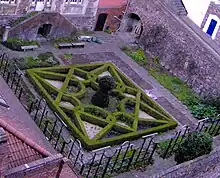A knot garden is a garden of formal design in a square frame, consisting of a variety of aromatic plants and culinary herbs including germander, marjoram, thyme, southernwood, lemon balm, hyssop, costmary, acanthus, mallow, chamomile, rosemary, Calendula, Viola and Santolina. Most knot gardens now have edges made from box (Buxus sempervirens), which is easily cut into desired shapes, like dense miniature hedges, and stays green during winters when not all of the "filling" plants are visible or attractive. The paths in between are usually laid with fine gravel. However, the original designs of knot gardens did not have the low box hedges, and knot gardens with such hedges might more accurately be called parterres.
Most Renaissance knot gardens were composed of square compartments. A small garden might consist of one compartment, while large gardens might contain six or eight compartments.
Characteristics
Knot gardens were based on Renaissance designs that were used in forms of indoor decoration such as textiles, carpets, wall coverings and cushions.[1] They are often designed to be viewed from above and encompass an interlocking or intertwining pattern using clipped common box, Buxus sempervirens.[2]
Unlike like French parterres, knot gardens are usually small and of varying heights where hedges form junctions to indicate the crossing or knotting of 'threads.'[3]
Examples

Knot gardens were first established in England in the reign of Queen Elizabeth I.
Some early knot gardens have been covered over by lawn or other landscaping, but the original traces are still visible as undulations in the present day landscape. An example of this phenomenon is the early 17th-century garden of Muchalls Castle in Scotland.
Knot gardens have become established in many temperate formal gardens throughout the world, including:
- Alexandra Hicks Herb Knot Garden, University of Michigan, USA
- Antony House, Cornwall, England
- Anzac Square, Dunedin, New Zealand[4]
- Astley Castle, Warwickshire, England[5]
- Barnsley House, Gloucestershire, England[6]
- Bourton House Garden, Gloucestershire, England
- Brooklyn Botanic Garden, New York City, USA
- Cleveland Botanical Garden, USA
- Compton Castle, Devon, England
- Garden Museum, London, England
- Hatfield House, Hertfordshire, England
- Helmingham Hall, Suffolk, England[7]
- Knowle, Solihull, England
- Little Moreton Hall, Cheshire, England[8]
- Red Lodge Museum, Bristol, England[9]
- St Fagans, South Wales
- Stoneleigh Abbey, Warwickshire, England
- Sudeley Castle, Cotswolds, England[10]
A knot garden is featured in Shakespeare's play Love's Labour's Lost.
 Knot Garden at Sudeley Castle, Gloucestershire, England
Knot Garden at Sudeley Castle, Gloucestershire, England Garden Museum, London, England
Garden Museum, London, England Little Moreton Hall Knot Garden, Cheshire, England
Little Moreton Hall Knot Garden, Cheshire, England Knot Garden at Moseley Old Hall, Wolverhampton, England
Knot Garden at Moseley Old Hall, Wolverhampton, England
See also
References
- ↑ "The knot garden". National Trust. Retrieved 2021-06-10.
- ↑ Coffey, Sally (2015-04-21). "The Tudors and their gardens". Britain Magazine | The official magazine of Visit Britain | Best of British History, Royal Family,Travel and Culture. Retrieved 2021-06-10.
- ↑ "Design: Tudor garden style". The English Garden. 2014-11-04. Retrieved 2021-06-10.
- ↑ "The Dunedin Railway Station". Cityofdunedin.com. Retrieved 2013-03-26.
- ↑ "A Landmark for the 21st century". Astley Castle. Retrieved 20 June 2020.
- ↑ Gloucestershire: the Cotswolds, The Buildings of England edited by Nikolaus Pevsner, 2nd ed. (1979) ISBN 0-14-071040-X, pp.96-100
- ↑ "The Knot Garden". Helmingham Hall. Retrieved 20 June 2020.
- ↑ Fedden, Robin; Joekes, Rosemary (1984). The National Trust Guide. The National Trust. pp. 155, 257. ISBN 978-0-224-01946-0.
- ↑ "The Red Lodge Museum". Culture 24. Retrieved 24 October 2015.
- ↑ "Visit the Castle Gardens". Sudeley Castle & Gardens. Retrieved 20 June 2020.
External links
 Media related to knot gardens at Wikimedia Commons
Media related to knot gardens at Wikimedia Commons- The Knot Garden in the Garden Museum, London
